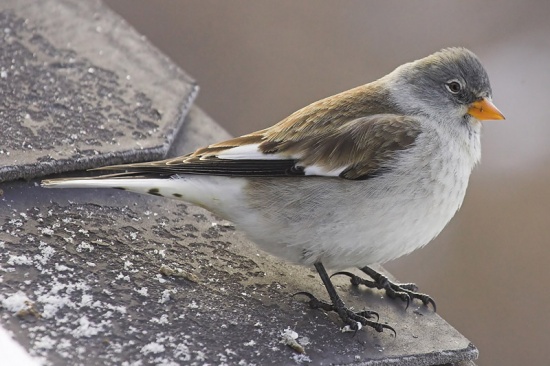Alternative names: Common Snowfinch; Eurasian Snowfinch
- Montifringilla nivalis
Identification
17 - 17.5cm. A large and long-winged Snowfinch.
- Conspicuous white panels on tail and wings in flight, narrow long wing-panel on ground
- Grey head with black bib in summer
- Dull earth-brown mantle
- Dirty white underparts
- Bill black in summer, ivory in winter
Sexes are similar. The subspecies differ mainly in size and plumage tone, nivalis being the darkest.
Similar species
See Black-winged Snowfinch and Tibetan Snowfinch.
May be mistaken for a Snow Bunting in flight but note much darker body plumage and less white in wing.
Distribution
Found in mountain ranges from Western Europe (northern Spain) to the Alps, Italy, Greece, Turkey, the Caucasus, Iran, Afghanistan, Tajikistan to China and Mongolia.
Common but usually local.
Taxonomy
Seven subspecies recognized:
- M. n. nivalis in Spain, France, Switzerland, Austria, Germany, Italy, Slovenia, Croatia, Albania, Bosnia and Herzegovina, Macedonia and Greece
- M. n. leucura in Turkey
- M. n. alpicola in the Caucasus, Iran and Afghanistan
- M. n. gaddi in the Zagros mountains, Iran
- M. n. tianshanica in the Tien Shan (Kazakhstan) and the Pamir mountains (Tajikistan)
- M. n. groumgrzimaili in northwestern China (eastern Tian Shan and Altai mountains in northern Xinjiang) east to central Mongolia
- M. n. kwenlunensis in southwestern China (southern Xinjiang: Kunlun Shan and Altun Shan ranges)
Both Tibetan Snowfinch and Black-winged Snowfinch have been included in this taxon in the past. All three form a superspecies.
Habitat
Occurs on barren rocky ground with cliffs and alpine meadows from the tree-line up to the snow-line. Often near buildings in high altitude ski resorts. Found at 2000 - 5300m.
Behaviour
Feeds on seeds and insects. Nestlings are fed with insects.
Usually seen in pairs or small groups, in winter in larger flocks.
Breeding season from May to August, mostly two broods. Breeds in loose colonies. The bulky nest is made of dry grass and moss and placed in a rock crevice or in a hole in a building or an artificial structure like a cable-car pylon. Sometimes the nest is also placed in a rodent burrow. Lays 4 - 5 eggs.
A resident species with some altitudinal movements in winter.
References
- Clements, J. F., T. S. Schulenberg, M. J. Iliff, T. A. Fredericks, J. A. Gerbracht, D. Lepage, S. M. Billerman, B. L. Sullivan, and C. L. Wood. 2022. The eBird/Clements checklist of Birds of the World: v2022. Downloaded from https://www.birds.cornell.edu/clementschecklist/download/
- Del Hoyo, J, A Elliott, and D Christie, eds. 2009. Handbook of the Birds of the World. Volume 14: Bush-shrikes to Old World Sparrows. Barcelona: Lynx Edicions. ISBN 978-8496553507
Recommended Citation
- BirdForum Opus contributors. (2024) White-winged Snowfinch. In: BirdForum, the forum for wild birds and birding. Retrieved 19 April 2024 from https://www.birdforum.net/opus/White-winged_Snowfinch
External Links
GSearch checked for 2020 platform.1







